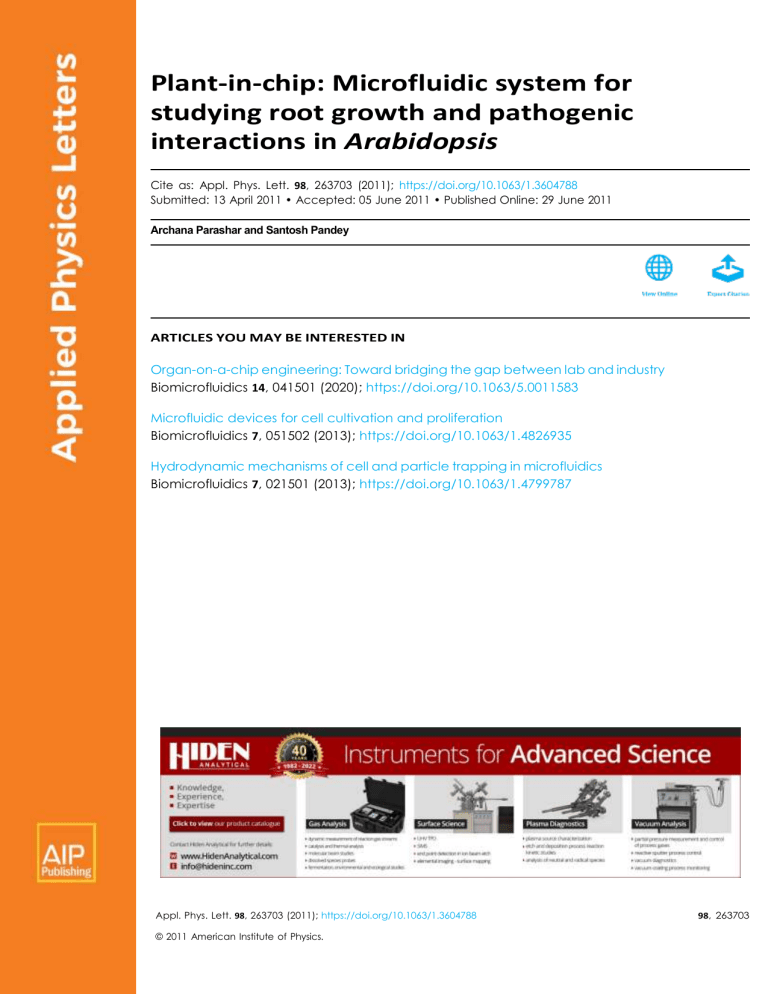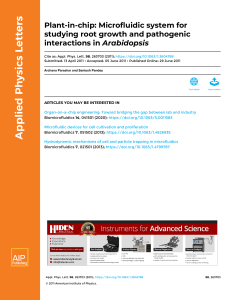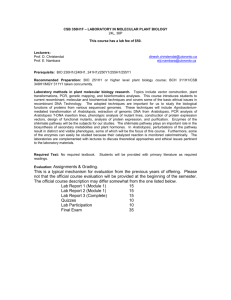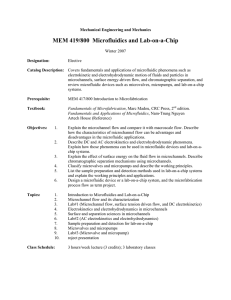
Plant-in-chip: Microfluidic system for
studying root growth and pathogenic
interactions in Arabidopsis
Cite as: Appl. Phys. Lett. 98, 263703 (2011); https://doi.org/10.1063/1.3604788
Submitted: 13 April 2011 • Accepted: 05 June 2011 • Published Online: 29 June 2011
Archana Parashar and Santosh Pandey
ARTICLES YOU MAY BE INTERESTED IN
Organ-on-a-chip engineering: Toward bridging the gap between lab and industry
Biomicrofluidics 14, 041501 (2020); https://doi.org/10.1063/5.0011583
Microfluidic devices for cell cultivation and proliferation
Biomicrofluidics 7, 051502 (2013); https://doi.org/10.1063/1.4826935
Hydrodynamic mechanisms of cell and particle trapping in microfluidics
Biomicrofluidics 7, 021501 (2013); https://doi.org/10.1063/1.4799787
Appl. Phys. Lett. 98, 263703 (2011); https://doi.org/10.1063/1.3604788
© 2011 American Institute of Physics.
98, 263703
APPLIED PHYSICS LETTERS 98, 263703 (2011)
Plant-in-chip: Microfluidic system for studying root growth and pathogenic
interactions in Arabidopsis
Archana Parashar and Santosh Pandeya)
Department of Electrical and Computer Engineering, Iowa State University, Ames, Iowa 50011, USA
(Received 13 April 2011; accepted 5 June 2011; published online 29 June 2011)
We report a microfluidic platform for the hydroponic growth of Arabidopsis plants with
high-resolution visualization of root development and root-pathogen interactions. The platform
comprises a set of parallel microchannels with individual input/output ports where 1-day old
germinated seedlings are initially placed. Under optimum conditions, a root system grows in each
microchannel and its images are recorded over a 198-h period. Different concentrations of plant
growth media show different root growth characteristics. Later, the developed roots are inoculated
with two plant pathogens (nematodes and zoospores) and their physicochemical interactions with
C 2011 American Institute of Physics. [doi:10.1063/1.3604788]
the live root systems are observed. V
Plant development is greatly dependent upon its interactions with the environment, which may present challenges to
its sessile lifestyle.1 On one hand, plants need to search for
essential resources such as light, water, and nutrients.1,2 On
the other hand, they need to compete with neighboring plants
for limited resources and defend themselves against soilborne pathogens.3–8 In this context, the root system has been
well-studied for elucidating the role of different genes,2,4
proteins,1,3 and phytohormones1,5 in the plasticity of root development.9 A number of important revelations have come
to light from root studies such as how plants regulate organ
growth rates,8 foraging responses,6 defense mechanisms,3
and cell cycle machinery.7 Observations of behavioral adaptability of root systems and associated genotype are providing
insights into key biophysical and biochemical processes in
plants (e.g., synthesis and transport of enzymes,4 cell production and expansion in growing tissues,7,8 nutrient sensing
and transduction,4 search and navigation strategies,5 and
evolution of phyllotactic patterns10–12) and the varied interrelationships (both symbiotic and parasitic) they establish
with their surroundings.
In the past three decades, several techniques were developed to study root development of the model plant, Arabidopsis thaliana. Besides being the first plant system to be
fully sequenced, Arabidopsis has been exploited for its
smaller size, ever increasing database of genetic information,
and the relative ease of screening mutants.1–3 Most studies
on root development were based on genetic analysis because
of the difficulty of characterizing root growth in soil pots. 5
For real-time observation of root architecture, agarose plates
have been used to grow Arabidopsis plants with controlled
local environments.10–13 However, such experiments on agarose plates have limited spatial resolution (in the millimeter
range) and throughput (one experimental condition per
plate).10,14 Recently, a microfluidic device with multilaminar flow was demonstrated to chemically stimulate a 10–
20 m section of a live Arabidopsis root, showing the
possible advantages of improved spatial and temporal resolution.14 In their work, Arabidopsis seeds were germinated,
a)
Electronic mail: pandey@iastate.edu.
0003-6951/2011/98(26)/263703/3/$30.00
grown on agarose plates for 7 or 11 days, and then transferred to open microchannels in a polydimethylsiloxane
(PDMS) (Ref. 15) mold. Subsequently, three converging
laminar streams were flowed in the device to observe the
effects of localized chemical stimulation on auxin transport
and root hair growth over a 24-h period.14
We hypothesized that germinated Arabidopsis seedlings
could be directly sown in microfluidic ports connected to
microchannels filled with a suitable growth medium. Under
optimum hydroponic growth conditions,16 the shoots would
grow upwards while the roots would grow into the microchannels. This could possibly allow the observation of
growth kinetics of multiple roots over long time periods with
the flexibility of testing plant responses to various abiotic
and biotic stresses. Building on this hypothesis, we present a
method of growing germinated Arabidopsis (Col-0) seedlings in a microfluidic platform (Fig. 1(a)). The device comprises eight parallel straight microchannels (length ¼ 1 cm,
width ¼ 350 m, height ¼ 80 m), each with its individual
input and output ports (diameter ¼ 2 mm). The SU-8 photoresist masters are made using standard soft lithography, 15
which are then used for rapid prototyping in PDMS. Each
PDMS mold, comprising the desired parallel microchannels,
is punched to create input/output ports and irreversibly
bonded to a microscope glass slide (75 mm x 25 mm x 0.2
mm) by exposure to oxygen plasma. The microchannels
are further connected with thin vertical side channels
(length ¼ 750 m, width ¼ 25 m, height ¼ 80 m) to alow
FIG. 1. (Color online) (a) Mask layout of the microfluidic device showing
the parallel microchannels with ports for housing seedlings and inoculation
of pathogens, (b) snapshot of multiple Arabidopsis roots growing in the
microchannels filled with DI water. The image is taken after 60 h of planting
the seedlings in the input ports.
98, 263703-1
VC 2011 American Institute of Physics
263703-2
A. Parashar and S. Pandey
the application of chemicals and pathogens in the entire
chip. Arabidopsis seeds are surface sterilized by treating in
5% sodium hypochlorite solution followed by washing three
times with distilled water and putting at 4 oC for 48 h to synchronize germination.9 After germination, seeds are transferred to half-strength Murashige and Skoog (MS) medium
and incubated at 23 oC for 24 h.9 The microchannels are
filled with a pre-specified growth medium. Each seedling is
hand-picked using sterile forceps and placed in individual
input ports. The chip is put in a Petri dish having a moist
wick (tissue paper), which is later sealed (with a parafilm)
and punched with perforations for ventilation. The Petri dish
is placed in a near vertical position under constant white
light intensity (approximately 80–100 E mÿ2 sÿ2) at
23 oC.16 Individual root systems in the entire chip are monitored and imaged for 198 h using a Leica MZ16 stereozoom
microscope and QImaging camera (Fig. 1(b)).
Fig. 2 shows the growth parameters of Arabidopsis roots
measured in four different fluid media (deionized (DI) water,
10% MS, 25% MS, and 50% MS). The transparent microfluidic chip is particularly useful in high-magnification imaging
and analysis of root structures (Fig. 2(a)). The root length
(L) is calculated as the distance from the root tip to the root
apex and is measured for 198 h of growth time (Fig. 2(b)).
Data are shown as mean 6 SD of at least 12–15 samples in
three replicates. In DI water, the growth rate (55.41 6 9.6
m/h) is steady during this time period. In 10%, 25% and
50% MS, the growth rate is higher in the first ~ 53 h
(41.97 6 17.0 m/h, 29.47 6 17.0 m/h, and 13.45 6 3.4
m/h, respectively) and becomes slower at later times (12.48
6 6.3 m/h, 5.92 6 2.1 m/h, and 3.16 6 2.9 m/h,
respectively). At the end of the growth period, the roots in
DI water are significantly longer (L ¼ 9344.95 6 901.3 m)
and thinner than those in 10% MS (L ¼ 4062.71 6 450.0
m), 25% MS (L ¼ 2689.44 6 588.7 m), or 50% MS media
(L ¼ 1275.43 6 53.9 m). Furthermore, root hairs are thinner
and longer in DI water compared to those in 25% and 50%
MS media. This observation is in agreement with current
literature17,18 that suggests that root systems are short,
Appl. Phys. Lett. 98, 263703 (2011)
compact, and densely branched in nutrient-rich growth
media (e.g., 50% MS), while they are long, thin, and sparsely
branched in more dilute media (e.g., DI water). In addition,
the root diameter (Fig. 2(c)) and cell length (Fig. 2(d)) are
measured along the root (for up to 4 mm from the root tip) at
the end of the growth period. For these measurements, highly
magnified images of the different root sections are recorded,
and QImaging calibration tools are used to extract the various physical dimensions. In each media, the root diameter is
roughly uniform throughout the root length (DI water:
100.86 6 8.6 m, 10% MS: 154.23 6 10.9 m, 25% MS:
111.53 6 6.3 m). However, there is significant difference
between the roots thicknesses measured in different growth
media (p < 0.05, one-way analysis of variance). The cell
length is smaller close to the root tip (DI water: 21.57 6 3.1
m, 10% MS 13.05 6 5.8 m, 25% MS 28.0 6 4.4 m) an
d
larger towards the root apex (DI water: 69.58 6 17.4 m,
10% MS 33.24 6 5.8 m, 25% MS 56.29 6 5.1 m).
Besides root development, we show that the microfluidic
platform is useful for studying root-pathogen interactions.
Both nematodes (e.g., sugarbeet nematode (SBN)) and
oomycetes (e.g., Phytophthora sojae) are known to establish
intimate relationships with numerous plants, resulting in several economically important diseases.19–24 Currently, functional genomic strategies of plant pathosystems,19,21 along
with microarray analyses and polymerase chain reaction
techniques,22 are providing exciting leads into the role of
specific genes in establishing biotrophic parasitism.3,8 It is,
however, difficult to visually observe early biophysical or
chemical interactions between pathogens and root systems
with real-time imaging.19–21 We inoculated the developed
roots in the microchannels with two pathogens: SBN and
P. sojae. Upon inoculation, the SBNs migrated through the
microchannels and found their way to the roots within the
first 1–2 h. Subsequently, they probed the root surface along
its length and started penetrating the cell layers in the next
12 h (Fig. 3(a)). No visual changes in the root were noticed
in the initial few hours. As such, image recordings were continued every 24 h for the next 4 days. After 2–3 days, some
FIG. 2. (Color online) Root growth parameters measured during hydroponic
growth of the Arabidopsis plants in the
microfluidic device with different concentrations of growth media. (a) Snapshots of the root tip (at the end of the
growth period) grown in DI water, 10%
MS, and 25% MS media, (b) root length
versus growth time, (c) root diameter,
and (d) cell length along the root (for the
first 4 mm from root tip) at the end of
198 h.
263703-3
Appl. Phys. Lett. 98, 263703 (2011)
A. Parashar and S. Pandey
and stress factors.6,14,18 The hydroponic growth of Arabidopsis seedlings in transparent, closed microenvironments over
long time periods offers improved throughput in conducting
parallel growth tests and eliminates the need of macroscopic
agarose plates14 for culturing seedlings. The real-time imaging of root-pathogen physicochemical interactions demonstrated here can significantly advance our knowledge about
the plethora of physiological and molecular changes undergoing in the host or non-host system during pathogenic
attack.3,4 Phenotypic characterization of the complex interactions between these multi-kingdom organisms in such microfluidic platforms can complement existing genetic and
proteomic screening tools16 aimed at engineering nematoderesistant plant mutants and identifying the possible defense
strategies (e.g., physical or chemical barriers)8,23 employed
by plant systems.
FIG. 3. (Color online) Illustration of interactions between the Arabidopsis
roots grown in microfluidic device with two plant pathogens. (a) Sugarbeet
nematodes, inoculated 2 h before, are probing the root surface (enhanced
online) [URL: http://dx.doi.org/10.1063/1.3604788]. Later, some of them
find their way to the root center and use their stylus to draw nutrients from
the root (enhanced online) [URL: http://dx.doi.org/10.1063/1.3604788].
(b) P. sojae zoospores, inoculated 24 h before, cluster around the root tip
and grow hyphae towards the root.
SBNs (n ¼ 3–5 per root) were found inside roots (usually
near the root apex) with their body aligned with the central
vein of the root. The rhythmic motion of the stylet (i.e., hollow and feeding tube) was observed in the real-time videos.25 This is characteristic of plant-parasitic nematodes that
use their stylets to secrete substances and establish feeding
sites within the root. Compared to SBNs (~ 400 m long),
P. sojae zoospores (i.e., motile spores) are much smaller in
size (~ 3–5 m in diameter) and show a different mode of
interaction. Upon inoculation, the zoospores swim randomly
in the microchannels and start settling at locations close to
the root tip in the first 2 h.22 They form clusters as they settle, encyst, germinate, and grow their hyphae22 (i.e., germ
tubes) in the next 6 h to penetrate the root tissues. In our control experiments (i.e., without roots), zoospores swell to
form appressoria and the hyphae generally grow in random
directions.23 In the presence of roots, appressoria are also
formed but with a majority of hyphae extending towards the
root (Fig. 3(b)). In subsequent days, the root tip appears
darker indicating possible localized cell death.24,25
In conclusion, this plant-in-chip platform harnesses the
known advantages of microfluidics technology15 to conduct
experiments in root development and root-pathogen interactions. We showed reliable and steady growth of Arabidopsis
roots in microchannels with imaging at cellular resolution.
The root morphology was influenced by different MS concentrations and opens possibilities of testing other nutrients
This work is supported by Grant No. NSF-CMMI1000808 from the National Science Foundation. We are
grateful to Madan Bhattacharya for providing the seeds and
zoospores, Thomas Baum for providing the plant-parasitic
nematodes, and Maneesha Aluru for advice on growth
conditions.
1
X. Fu and N. P. Harberd, Nature (London) 421, 740 (2003).
Q. Li, B. Li, H. J. Kronzucker, and W. Shi, Plant, Cell Environ. 33, 1529
(2010).
3
J. L. Dangl and J. D. G. Jones, Nature (London) 411, 826 (2001).
4
B. Forde and H. Lorenzo, Plant Soil 232, 51 (2001).
5
P. Achard, H. Cheng, L. D. Grauwe, J. Decat, H. Schoutteten, T. Moritz,
D. V. Straeten, J. Peng, and N. P. Harberd, Science 311, 91 (2006).
6
H. Zhang and B. G. Forde, Science 279, 407 (1998).
7
G. Beemster and T. I. Baskin, Plant Physiol. 116, 1515 (1998).
8
G. Beemster and T. I. Baskin, Plant Physiol. 124, 1718 (2000).
9
P. N. Benfey, P. J. Linstead, K. Roberts, J. W. Schiefelbein, M. Hauser,
and R. A. Aeschbacher, Development 119, 57 (1993).
10
C. S. Buer, J. Masle, and G. O. Wasteneys, Plant Cell Physiol. 41, 1164
(2000).
11
H. Kanani, B. Dutta, and M. I. Klapa, BMC Syst. Biol. 4, 177 (2010).
12
F. Migliaccio, A. Fortunati, and P. Tassone, Plant Signaling Behav. 4, 183
(2009).
13
N. D. Miller, B. M. Parks, and E. P. Spalding, Plant J. 52, 374 (2007).
14
M. Meier, E. M. Lucchetta, and R. F. Ismagilov, Lab Chip 10, 2147
(2010).
15
D. B. Weibel, W. R. DiLuzio, and G. M. Whitesides, Nat. Rev. Microbiol.
5, 209 (2007).
16
B. Dutta, H. Kanani, J. Quackenbush, and M. I. Klapa, Biotechnol. Bioeng. 102, 264 (2009).
17
T. Ingestad and G. I. Agren, Ecol. Appl. 1, 168 (1991).
18
H. Zhang, A. J. Jennings and B. G. Forde, J. Exp. Biol. 51, 51 (2000).
19
W. Grunewald, G. van Noorden, G. van Isterdael, T. Beeckman, G. Gheysen, and U. Mathesius, Plant Cell 21, 2553 (2009).
20
N. Wuyts, G. Lognay, R. Swenne, and D. De Waele, J. Exp. Biol. 57, 2825
(2006).
21
V. M. Williamson and C. A. Gleason, Curr. Opin. Plant Biol. 6, 327
(2003).
22
E. Huitema, J. I. Bos, M. Tian, J. Win, M. E. Waugh, and S. Kamoun,
Trends Microbiol. 12, 193 (2004).
23
P. F. Morris, E. Bone, and B. M. Tyler, Plant Physiol. 117, 1171 (1998).
24
J. E. Rookes, M. L. Wright, and D. M. Cahill, Physiol. Mol. Plant Pathol.
72, 151 (2008).
25
See supplementary material at http://dx.doi.org/10.1063/1.3604788 showing pathogens (SBNs and P. sojae) interacting with the Arabidopsis roots
in microchannels.
2







